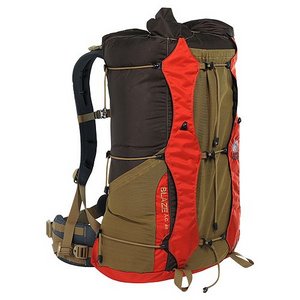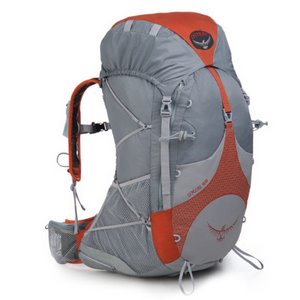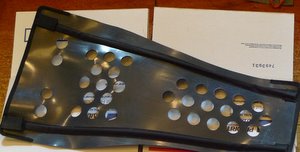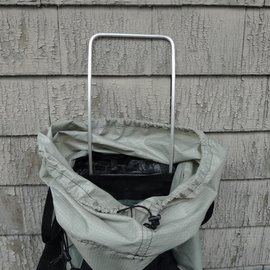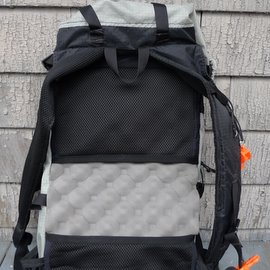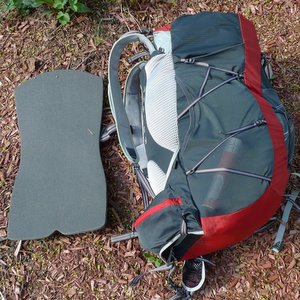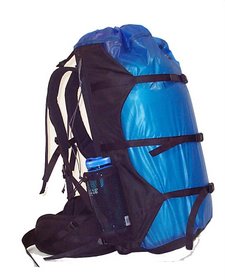Introduction
This is the fourth post in my series, an Introduction to Lightweight Backpacking, that explains how to reduce the weight of The Big Three: your tent, sleeping bag, and backpack. If you feel like your pack weight is too heavy on backpacking trips, replacing these items with lighter weight alternatives is the fastest, most effective way to reduce your load to a more comfortable 25 pounds.
In last week's post, Lightweight Backpacking: Sleeping Bag Makeover, I reviewed the weight, fit, insulation, and functional tradeoffs between sleeping bags and quilts to help you buy one that weighs 3 pounds or less.
Two weeks ago, in Lightweight Backpacking: Shelter Makeover, I explained how to lighten your existing tent and what to look for if you decide to purchase a new one weighing less than 3 pounds. I also introduced several ultralight-style camping shelters, including tarp tents, which are an excellent way to trim gear weight without requiring major changes to your campsite setup routine.
In this post, I focus on backpacks that weigh between 1 and 3 pounds and can carry 20 to 30 pounds of gear. I explain how to size them, how to choose a pack made with durable fabrics, and how backpack suspensions work. I then survey the different types of internal frame and frameless suspension systems available.
If you are expecting a post evangelizing the benefits of frameless, ultralight backpacks that weigh under 1 pound or are made with very expensive ultralight fabrics, you are going to be disappointed. This post is for three season backpackers who want to carry less weight, but like to bring a few luxury items with them on the trail. That said, there are mainstream and smaller manufacturers that make durable ultralight packs with augmented suspension systems, and I list some of their packs below.
How to Choose a Lightweight Backpack
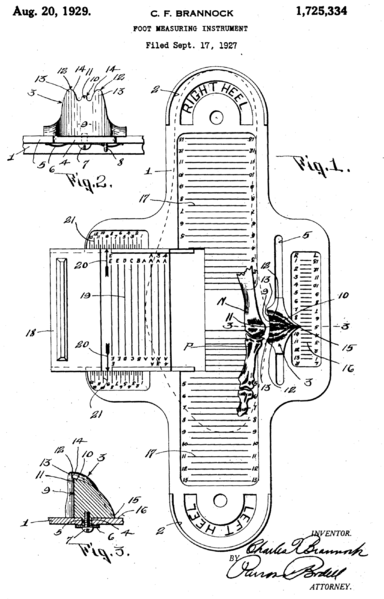
Shoe measuring device
Buying a backpack is a lot like buying a pair of shoes. Before you can purchase them, you need to know your size. You need to decide what style of shoe you like, whether you want leather shoes or not, how durable they need to be, and how much you are willing to spend. Then, you need to try on a wide selection of shoes and sizes until you find a pair you like.
It's the same situation with a backpack. Before you start looking for a new pack, it is important that you measure your torso length and hip girth so you know what size pack you need. You should also measure the weight and volume of your pack contents, so that you select packs that have the right suspension system and capacity to carry your gear comfortably.
Like shoes, it's best to try several packs before you buy one since there are many factors beyond size or suspension type that contribute to a pack's comfort. Try out a number of different pack styles to understand how they perform with different loads and what features you like and don't like.
Whatever you do, don't trust manufacturers' claims about maximum gear weight or pack capacity. These are often wrong, misleading, or difficult to reproduce. The best test is to take a few long day hikes with a loaded pack before you purchase a backpack that you'll need to live with for a few years.
Gear Weight and Volume
In my previous posts, I emphasized the importance of weighing your existing gear on a digital postage or kitchen scale to help you make more informed decisions about which gear to replace and which to keep.
Gear Weight
You need to know how much the gear in your pack weighs so that you can match its weight to an appropriate suspension system. While it's best to itemize everything on your gear list and keep it in a spreadsheet, for now, you can drop everything into a cardboard box and weigh it on a digital postage or kitchen scale to determine the base weight of your pack. Don't include the clothing you wear or the weight of the box, just the gear you typically carry in your pack, including your cell phone, wallet, keys, maps, permits and other personal items.
Next, add up the weight of your consumables: food, fuel, and water, that you carry on an average length trip. To calculate this, add 1.5 pounds per day for food, 2 pounds per liter of water, and 1 pound of fuel per trip. Although not exact, these numbers provide a useful estimate.
Adding your base weight to your consumables weight will give you a ballpark figure for the total weight of the contents of your pack at the beginning of an average backpacking trip. When shopping for a new pack, you don't have to buy one that is comfortable for your maximum load, at the beginning of a trip, because this weight will drop rapidly as you hike and eat your food.
Gear Volume

Measuring gear volume
In addition to the weight of your gear, you need to get a ballpark figure for the volume for your gear and consumables so you can get a backpack that is large enough to hold them.
Using the cardboard box from the previous step, pack all of your gear into the box tightly so there's as little free space as possible. Add the water bottles you normally carry on trips or a full hydration reservoir if you use one, the bottle or canister you use to hold stove fuel, and the food for your average trip. If you don't have backpacking food readily available, simulate its volume using bags of granola, rice, or nuts and level everything off so the top is fairly flat.
Next, measure the height of your gear in the box, in inches, and multiply that by the width and length of the box's base. This will yield the number of cubic inches or maximum backpack capacity you need at the beginning of a trip. Some pack manufacturers have switched to liters to describe pack capacity, so you may need to convert cubic inches to liters. I list both measures in my survey of lightweight backpacks below.
If you've already reduced the weight of your other Big Three items so that they each weigh under 3 pounds, the capacity you need might already be far less than you realize. If not, you should defer the purchase of a new pack until you have replaced your tent and sleeping bag. Otherwise, you are likely to buy a pack that is much larger than you need.
How to Fit a Backpack
Before you start shopping for a new backpack, you need to compile a list of measurements to help you find a backpack that fits your physical proportions.
Torso Length
Backpacks are sized in relation to the torso lengths they fit. This is the distance between your 7th vertebra and your hipbones. if you've never measured your torso length, here is a short video from REI that explains how to measure it.
Torso length is the most important factor in buying a comfortably fitting pack and you should never buy a pack that has a torso length smaller than your own. If you shop at an outfitter, it's easy to get a sales person who knows less about pack fitting than you do. Your best bet is to come to the store knowing what your torso size is, and to eliminate packs or pack sizes that don't fit.
Hip Belt Size
Backpack suspensions are designed to get the weight of your pack off of your shoulders and on to your hips and legs. To do this, you need a hip belt that fits properly over your hipbones. Unfortunately, it's not uncommon to find a hip belt size that isn't long enough to fit over your hips, even though the pack's torso size is right on.
While some manufacturers make backpacks with replaceable hip belts, many don't, and you'll need to find another pack. If the hip belt does fit you, check to see how it feels when you are wearing extra layers like an insulated jacket and a rain shell. The hip belt should have extra length to wear with warmer clothing for shoulder season trips in early spring or late autumn.
Durability
Durability is a common concern among backpackers who are transitioning from heavier backpacks to lighter weight packs. Historically, lighter packs suffered from abrasion and seam strength problems. In the past, lightweight and ultralight packs were made with silicone-impregnated nylon which is lightweight but very susceptible to abrasion, punctures and tearing.
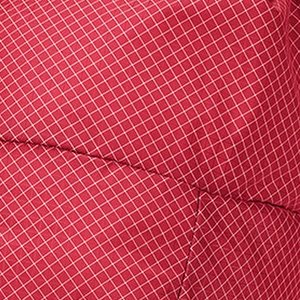
Dyneema fabric
Today, most backpack manufacturers have switched to more durable fabrics such as Dyneema, which is used to make bulletproof vests, and a variety of ripstop nylons, including Cordura, which is used to make travel luggage.
Manufacturers have also changed their pack designs to reinforce areas that experience high abrasion levels such as pack bottoms, and moved side pockets higher up on the sides of packs to reduce wear and tear. They have also replaced larger weave mesh pockets with finer weaves that are more resistant to tearing or replaced the mesh entirely with solid fabric to prevent branches from getting caught in the mesh and producing tearing.
Despite the use of tougher fabrics, lightweight backpacks are still intended for three-season use on hiking trails and rock scrambling where a close fitting pack is required for good maneuverability. They are not intended for winter backpacking or bushwhacking where pack cloth or thicker fabrics are required to prevent damage to your pack.
Backpack Suspension Systems
Before I dive into the different types of lightweight backpacks available, it's useful to review how backpack suspensions and frame systems work.
Backpack suspension systems are designed to transfer the weight of your pack from your shoulders to your hips and legs, which are the largest muscles of your body. The suspension system of a backpack suitable for 20 to 30 pounds loads, usually includes a frame, a back panel, shoulder straps, load lifters, a hip belt, stabilizer straps, and a sternum strap.
The frame helps a backpack retain the pack's shape when loaded and helps transfer pack weight to an attached hip belt. If the hip belt is properly fitted over the tops of your hipbones, it helps lift the frame up off your shoulders so that they carry less weight.
The degree of weight transfer between your shoulders and hips is dependent on matching your torso length to the torso length of the pack. If the pack's torso length is too short for you, your hip belt can't lift the pack weight high enough to relieve the pressure on your shoulders.
Lightweight Backpack Frames
There are five types of frame systems used in lightweight backpacks: internal frames, foam-covered framesheets, foam pads and stays, foam pads, and so-called frameless packs that don't have a built-in frame. All of these frame types can be used to carry 20-30 pound pack loads. While some of these frame types are heavy-duty enough to carry loads in excess of 30 pounds, it's not necessary to use a heavy duty frame to carry a lighter weight load, resulting in additional weight savings.
Internal Frames
A classic internal frame pack has an outer frame that runs along the outside of a pack's back panel, and the pack's shoulder pads and hip belt are attached directly to it. This provides excellent shoulder to hip load transfer when the hip belt is worn properly. It's a misconception that internal frame packs are too heavy for lightweight backpacking and there are some excellent packs available if you prefer using an internal frame suspension.
These packs are very good if you have to carry 30 pounds or more but are often heavier than the other frame types and can be overkill for lighter loads. Knowing your total average gear weight will be useful in making a decision.
I've listed several lightweight internal frame packs below that weigh less than 3 pounds in all of the torso lengths in which they're offered. If you have a shorter torso length, there are more internal frame packs available under 3 pounds, but you'll need to do some legwork to find them.
| Pack | Pounds/Ounces | Liters (Cubic Inches) | Frame Type | MSRP |
| REI Venturi 45 | 2 lb 15 oz | 45 L (2746 cu in) | Internal Frame | $129 |
| Osprey Talon 44 | 2b 10 oz | 44 L (2700 cu in) | Internal Frame | $149 |
| Osprey Exos 58 | 2 lb 10 oz | 61 L (3700 cu in) | Internal Frame | $219 |
Of these, the Osprey Exos 58, is probably the most popular internal frame pack in this weight range. A lot of hikers prefer this pack because you can go light with it or carry heavier, higher volume loads for longer trips.
Framesheets
A framesheet is usually a rigid piece of plastic inserted behind the padded back panel on a pack. It's different from a classic internal frame pack because there's no frame running around the perimeter of the pack and the pack's shoulder straps and hip belt are not directly attached to it. Despite this, the backpacking industry and retailers label them as internal frame packs.
While using a framesheet, is less efficient in transferring pack weight onto your hip belt, it is sufficient for 20-30 pounds loads as long as the framesheet is rigid enough to push up against the shoulder straps and prevent the back of the pack from bowing or slumping forward. Some manufacturers rate the maximum load for packs with this type of frame higher than 30 pounds, but it's unclear how well these claims hold up in actual backpacking conditions.
| Pack | Pounds/Ounces | Liters (Cubic Inches) | Frame Type | MSRP |
| Granite Gear Blaze AC 60 | 2lb 14 oz | 60 L (3660 cu in) | Framesheet | $200 |
| GoLite Pursuit | 2 lb 12 oz | 51 L (3111 cu in) | Framesheet | $165 |
| GoLite Women's Quest | 2 lb 10 oz | 62 L (3782 cu in) | Framesheet | $175 |
| REI Flash 50 | 2 lb 10 oz | 50 L (3051 cu in) | Framesheet | $149 |
All of the packs listed here have sewn-in foam padded framesheets with the exception of the REI Flash 50. The framesheet on this pack is optional and can be removed, reducing the weight of the pack to 1 pound 13 ounces. This is great for hikers who want to try a frameless, ultralight style of hiking, but don't want buy a second pack to try it out.
Gossamer Gear Gorilla pack stay and sleeping pad pocket
Foam Pad with Stays
Pack stays are lightweight rods that add to the stiffness of a framesheet or foam pad when it is used as a pack frame. The use of stays like this is popular because it can significantly boost the carrying capacity of a pack with a very lightweight and less rigid frame.
| Pack | Pounds/Ounces | Liters (Cubic Inches) | Frame Type | MSRP |
| ULA Catalyst | 2 lb 15 oz | 75 L (4600 cu in) | Foam Pad w/Stays | $250 |
| Six Moon Designs Starlite | 1 lb 14 oz | 67 L (4200 cu in) | Foam Pad w/Stays | $180 |
| Gossamer Gear Gorilla | 1 lb 8.2 oz | 46 L (2800 cu in) | Foam Pad w/Stays | $180 |
For example, backpacks from manufacturers Six Moon Designs and Gossamer Gear have special pockets on the backs of their packs to hold closed cell foam sleeping pads. This lets you use your sleeping pad as part of your backpack suspension system and can lighten your pack weight by a half pound or more. The pad pockets are located on the outside of the pack instead of a built-in back panel to avoid reducing the storage capacity of the pack's main compartment.
The problem with using just a soft sleeping pad as a frame is that it's not very rigid and its carrying capacity tops out at about 20 pounds. When augmented with a pair of aluminum stays, the carry weight of these packs is increased very significantly, with very little added weight, boosting their carry capacity up to 30-35 pounds.
Another nice property of these ULA, Six Moon and Gossamer Gear packs is that their pack stays are optional and can be removed so that hikers who want to experiment with a much lighter pack weight can use the same pack for lighter and heavier loads.
Foam Pads
Stiff foams pads are also used as frames in lightweight packs. These can be as effective as framesheets when they are used in conjunction with a good compression system.
| Pack | Pounds/Ounces | Liters (Cubic Inches) | Frame Type | MSRP |
| GoLite Pinnacle | 2 lb | 72 L (4392 cu in) | Foam Pad | $175 |
| GoLite Jam | 1 lb 15 oz | 50 L (3050 cu in ) | Foam Pad | $150 |
| Osprey Hornet 46 | 1 lb 8 oz | 46 L (2760 cu in) | Foam Pad | $159 |
All of the packs listed here are also known for their streamlined design. For example, the GoLite Pinnacle and Jam packs have noticeably fewer pockets and external attachment points than many other lightweight packs. This helps keep a backpacker's load closer to their center of gravity and above their hips, improving the effectiveness of load transfer form the shoulders to the hips.
The foam pads in all of these packs are also removable and so the pack can be used as a frameless ultralight backpack.
Frameless Packs
Frameless backpacks are essentially empty sacks with shoulder straps and hip belts attached, compression straps, and external pockets. While they don't have built-in frame, it's still necessary for hikers to create a virtual frame using a sleeping pad or by carefully packing their gear to provide to provide the pack with some structure.
The most common way to do this is to coil up a closed cell sleeping pad, like a Therm-a-Rest RidgeRest and put it in the pack's main compartment. Gear and food are packed in the middle just like a normal pack. This kind of virtual frame is surprisingly effective for loads up to 20 pounds, particularly if a pack has a good compression system to snug the main compartment closer to your back and you use a firm sleeping pad.
| Pack | Pounds/Ounces | Liters (Cubic Inches) | Frame Type | MSRP |
| Equinox Katahdin | 1 lb 10 oz | 53 L (3350 cu in) | Frameless | $110 |
| Granite Gear Virga | 1 lb 3 oz | 52 L (3200 cu in) | Frameless | $110 |
| Mountain Laurel Designs Ark | 1 lb 1.5 oz | 72 L (4400 cu in) | Frameless | $195 |
It is also possible to create a virtual frame without a sleeping pad using just your gear and food. This takes a lot of practice and experimentation, but it's useful if you've switched from a closed cell sleeping pad to a lightweight inflatable sleeping pad like the Therm-a-Rest NeoAir.
Conclusion
As you can see, there are a wide selection of lightweight backpacks available to hikers who want to replace their existing pack with one that weighs 3 lbs or less. All of the packs I've list here are considered best of breed in the category and can carry loads ranging from 20 to 30 pounds.
If you decide to buy a lightweight pack, consider purchasing one that has optional removable components. Once you've reduced the weight of your Big Three, you may want to continue lightening your pack by removing unnecessary items or by replacing your existing gear with lighter weight alternatives. Packs with removable options give you a lot more flexibility to experiment with even lighter loads and can help you avoid having to buy another pack if your needs change.
Next up, we'll discuss stove systems next week »
Philip's Recommended Backpack Manufacturers
Gossamer Gear (Full disclosure: I'm a backpacking evangelist for Gossamer Gear.)
Philip Werner is the author of SectionHiker.com, a blog about lightweight backpacking and hiking. A popular speaker, Philip gives frequent backpacking talks and gear demonstrations across New England. In addition, he is a Long Trail mentor for the Green Mountain Club, a trail adopter in the White Mountain National Forest, and a lightweight backpacking evangelist for Gossamer Gear.

 by Philip Werner
by Philip Werner
